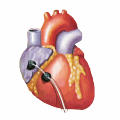



|

|

|
HeartLander in the news: |
Epicardial AccessThrough a 25 mm percutaneous incision and 10 mm pericardial incision, HeartLander has demonstrated the ability to travel to any location on the epicardial surface of the beating porcine (pig) heart. These locomotion paths originate near the apex of the heart and move along straight trajectories toward the base of the heart. The locomotion paths can be examined in 3D from the position sensor data, and overlayed on a surface model of the heart (see figure below). After reaching the target location, HeartLander provides a stable platform from which to administer therapy. Additional details regarding
locomotion access and precise positioning on the epicardium of the
beating porcine heart through a single percutaneous incision are
awaiting publication.
Pacing Lead PlacementUsing HeartLander, a cardiac surgeon was able to successfully deploy a pacing lead into the left ventrical of a beating porcine heart through a 25 mm percutaneous incision and 10 mm pericardial incision. The surgeon drove the robot to the target location on the left ventrical, then used the active fixation mechanism of the lead to secure it into the myocardium. Successful placement of the lead was confirmed by fluoroscopy and actual electrical pacing tests (see figures below). No adverse hemodynamic or electrophysiologic events were noted during the trial. A histological study of the excised heart verified that no epicardial damage was caused by the locomotion. 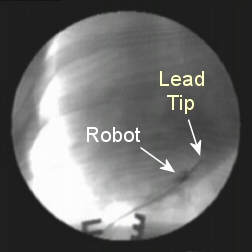
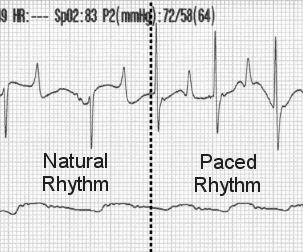
Myocardial InjectionsHeartLander has be used to inject patterns of dye marks into the myocardium of the beating porcine heart through the same subxiphoid approach described above. The surgeon drove the robot to the target location, which was verified using the position tracking data. The remote needle injection system then allowed the surgeon to advance the needle into the tissue and perform the dye injections from outside the animal. The injection depths were measured from the excised heart following the testing, and averaged 3-5 mm (see figure below). No adverse hemodynamic or electrophysiologic events were noted during these trials. 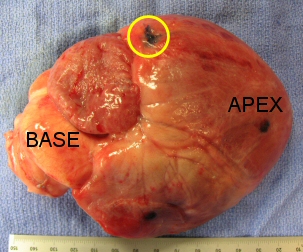
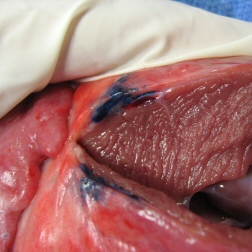
|